Tamim Asfour
Adaptive Domain Modeling with Language Models: A Multi-Agent Approach to Task Planning
Jun 24, 2025Abstract:We introduce TAPAS (Task-based Adaptation and Planning using AgentS), a multi-agent framework that integrates Large Language Models (LLMs) with symbolic planning to solve complex tasks without the need for manually defined environment models. TAPAS employs specialized LLM-based agents that collaboratively generate and adapt domain models, initial states, and goal specifications as needed using structured tool-calling mechanisms. Through this tool-based interaction, downstream agents can request modifications from upstream agents, enabling adaptation to novel attributes and constraints without manual domain redefinition. A ReAct (Reason+Act)-style execution agent, coupled with natural language plan translation, bridges the gap between dynamically generated plans and real-world robot capabilities. TAPAS demonstrates strong performance in benchmark planning domains and in the VirtualHome simulated real-world environment.
Safe Reinforcement Learning of Robot Trajectories in the Presence of Moving Obstacles
Nov 08, 2024Abstract:In this paper, we present an approach for learning collision-free robot trajectories in the presence of moving obstacles. As a first step, we train a backup policy to generate evasive movements from arbitrary initial robot states using model-free reinforcement learning. When learning policies for other tasks, the backup policy can be used to estimate the potential risk of a collision and to offer an alternative action if the estimated risk is considered too high. No matter which action is selected, our action space ensures that the kinematic limits of the robot joints are not violated. We analyze and evaluate two different methods for estimating the risk of a collision. A physics simulation performed in the background is computationally expensive but provides the best results in deterministic environments. If a data-based risk estimator is used instead, the computational effort is significantly reduced, but an additional source of error is introduced. For evaluation, we successfully learn a reaching task and a basketball task while keeping the risk of collisions low. The results demonstrate the effectiveness of our approach for deterministic and stochastic environments, including a human-robot scenario and a ball environment, where no state can be considered permanently safe. By conducting experiments with a real robot, we show that our approach can generate safe trajectories in real time.
On Probabilistic Pullback Metrics on Latent Hyperbolic Manifolds
Oct 28, 2024Abstract:Gaussian Process Latent Variable Models (GPLVMs) have proven effective in capturing complex, high-dimensional data through lower-dimensional representations. Recent advances show that using Riemannian manifolds as latent spaces provides more flexibility to learn higher quality embeddings. This paper focuses on the hyperbolic manifold, a particularly suitable choice for modeling hierarchical relationships. While previous approaches relied on hyperbolic geodesics for interpolating the latent space, this often results in paths crossing low-data regions, leading to highly uncertain predictions. Instead, we propose augmenting the hyperbolic metric with a pullback metric to account for distortions introduced by the GPLVM's nonlinear mapping. Through various experiments, we demonstrate that geodesics on the pullback metric not only respect the geometry of the hyperbolic latent space but also align with the underlying data distribution, significantly reducing uncertainty in predictions.
A Riemannian Framework for Learning Reduced-order Lagrangian Dynamics
Oct 24, 2024


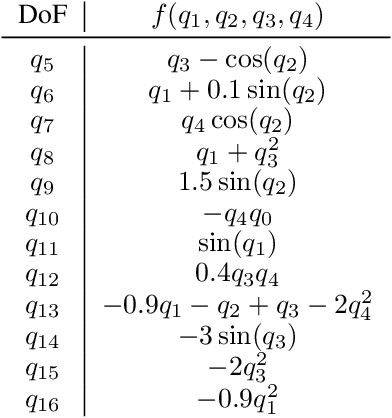
Abstract:By incorporating physical consistency as inductive bias, deep neural networks display increased generalization capabilities and data efficiency in learning nonlinear dynamic models. However, the complexity of these models generally increases with the system dimensionality, requiring larger datasets, more complex deep networks, and significant computational effort. We propose a novel geometric network architecture to learn physically-consistent reduced-order dynamic parameters that accurately describe the original high-dimensional system behavior. This is achieved by building on recent advances in model-order reduction and by adopting a Riemannian perspective to jointly learn a structure-preserving latent space and the associated low-dimensional dynamics. Our approach enables accurate long-term predictions of the high-dimensional dynamics of rigid and deformable systems with increased data efficiency by inferring interpretable and physically plausible reduced Lagrangian models.
Learning Spatial Bimanual Action Models Based on Affordance Regions and Human Demonstrations
Oct 11, 2024Abstract:In this paper, we present a novel approach for learning bimanual manipulation actions from human demonstration by extracting spatial constraints between affordance regions, termed affordance constraints, of the objects involved. Affordance regions are defined as object parts that provide interaction possibilities to an agent. For example, the bottom of a bottle affords the object to be placed on a surface, while its spout affords the contained liquid to be poured. We propose a novel approach to learn changes of affordance constraints in human demonstration to construct spatial bimanual action models representing object interactions. To exploit the information encoded in these spatial bimanual action models, we formulate an optimization problem to determine optimal object configurations across multiple execution keypoints while taking into account the initial scene, the learned affordance constraints, and the robot's kinematics. We evaluate the approach in simulation with two example tasks (pouring drinks and rolling dough) and compare three different definitions of affordance constraints: (i) component-wise distances between affordance regions in Cartesian space, (ii) component-wise distances between affordance regions in cylindrical space, and (iii) degrees of satisfaction of manually defined symbolic spatial affordance constraints.
Episodic Memory Verbalization using Hierarchical Representations of Life-Long Robot Experience
Sep 26, 2024Abstract:Verbalization of robot experience, i.e., summarization of and question answering about a robot's past, is a crucial ability for improving human-robot interaction. Previous works applied rule-based systems or fine-tuned deep models to verbalize short (several-minute-long) streams of episodic data, limiting generalization and transferability. In our work, we apply large pretrained models to tackle this task with zero or few examples, and specifically focus on verbalizing life-long experiences. For this, we derive a tree-like data structure from episodic memory (EM), with lower levels representing raw perception and proprioception data, and higher levels abstracting events to natural language concepts. Given such a hierarchical representation built from the experience stream, we apply a large language model as an agent to interactively search the EM given a user's query, dynamically expanding (initially collapsed) tree nodes to find the relevant information. The approach keeps computational costs low even when scaling to months of robot experience data. We evaluate our method on simulated household robot data, human egocentric videos, and real-world robot recordings, demonstrating its flexibility and scalability.
Force Myography based Torque Estimation in Human Knee and Ankle Joints
Sep 17, 2024Abstract:Online adaptation of exoskeleton control based on muscle activity sensing is a promising way to personalize exoskeletons based on the user's biosignals. While several electromyography (EMG) based methods have been shown to improve joint torque estimation, EMG sensors require direct skin contact and complex post-processing. In contrast, force myography (FMG) measures normal forces from changes in muscle volume due to muscle activity. We propose an FMG-based method to estimate knee and ankle joint torques by combining joint angles and velocities with muscle activity information. We learn a model for joint torque estimation using Gaussian process regression (GPR). The effectiveness of the proposed FMG-based method is validated on isokinetic motions performed by two subjects. The model is compared to a baseline model using only joint angle and velocity, as well as a model augmented by EMG data. The results show that integrating FMG into exoskeleton control improves the joint torque estimation for the ankle and knee and is therefore a promising way to improve adaptability to different exoskeleton users.
PerAct2: A Perceiver Actor Framework for Bimanual Manipulation Tasks
Jun 29, 2024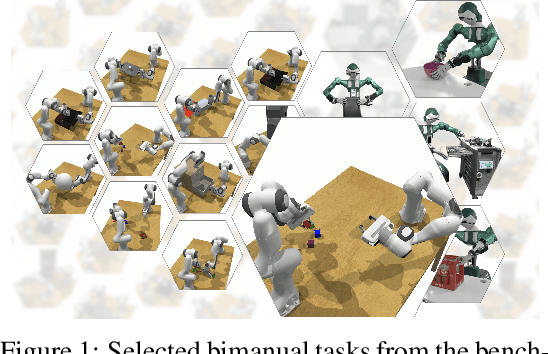
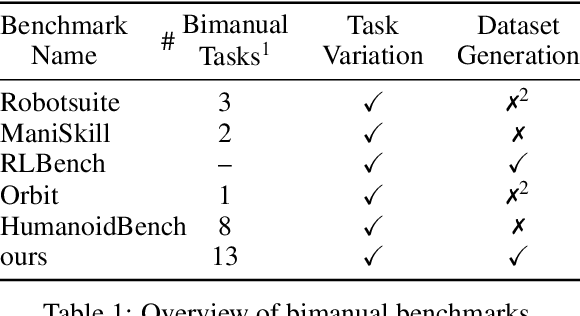


Abstract:Bimanual manipulation is challenging due to precise spatial and temporal coordination required between two arms. While there exist several real-world bimanual systems, there is a lack of simulated benchmarks with a large task diversity for systematically studying bimanual capabilities across a wide range of tabletop tasks. This paper addresses the gap by extending RLBench to bimanual manipulation. We open-source our code and benchmark comprising 13 new tasks with 23 unique task variations, each requiring a high degree of coordination and adaptability. To kickstart the benchmark, we extended several state-of-the art methods to bimanual manipulation and also present a language-conditioned behavioral cloning agent -- PerAct2, which enables the learning and execution of bimanual 6-DoF manipulation tasks. Our novel network architecture efficiently integrates language processing with action prediction, allowing robots to understand and perform complex bimanual tasks in response to user-specified goals. Project website with code is available at: http://bimanual.github.io
SciEx: Benchmarking Large Language Models on Scientific Exams with Human Expert Grading and Automatic Grading
Jun 14, 2024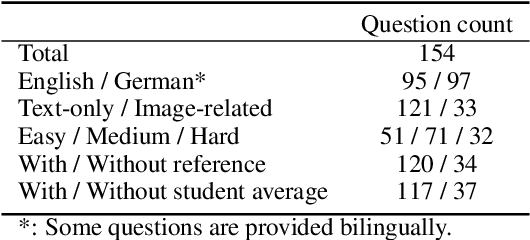
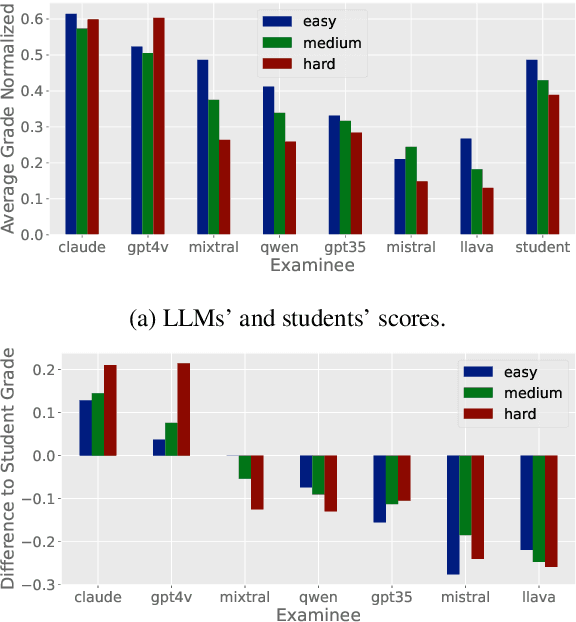

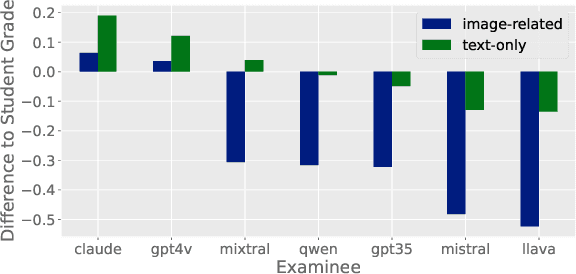
Abstract:With the rapid development of Large Language Models (LLMs), it is crucial to have benchmarks which can evaluate the ability of LLMs on different domains. One common use of LLMs is performing tasks on scientific topics, such as writing algorithms, querying databases or giving mathematical proofs. Inspired by the way university students are evaluated on such tasks, in this paper, we propose SciEx - a benchmark consisting of university computer science exam questions, to evaluate LLMs ability on solving scientific tasks. SciEx is (1) multilingual, containing both English and German exams, and (2) multi-modal, containing questions that involve images, and (3) contains various types of freeform questions with different difficulty levels, due to the nature of university exams. We evaluate the performance of various state-of-the-art LLMs on our new benchmark. Since SciEx questions are freeform, it is not straightforward to evaluate LLM performance. Therefore, we provide human expert grading of the LLM outputs on SciEx. We show that the free-form exams in SciEx remain challenging for the current LLMs, where the best LLM only achieves 59.4\% exam grade on average. We also provide detailed comparisons between LLM performance and student performance on SciEx. To enable future evaluation of new LLMs, we propose using LLM-as-a-judge to grade the LLM answers on SciEx. Our experiments show that, although they do not perform perfectly on solving the exams, LLMs are decent as graders, achieving 0.948 Pearson correlation with expert grading.
Influence of Motion Restrictions in an Ankle Exoskeleton on Gait Kinematics and Stability in Straight Walking
Jun 10, 2024Abstract:Exoskeleton devices impose kinematic constraints on a user's motion and affect their stability due to added mass but also due to the simplified mechanical design. This paper investigates how these constraints resulting from simplified mechanical designs impact the gait kinematics and stability of users by wearing an ankle exoskeleton with changeable degree of freedom (DoF). The exoskeleton used in this paper allows one, two, or three DoF at the ankle, simulating different levels of mechanical complexity. This effect was evaluated in a pilot study consisting of six participants walking on a straight path. The results show that increasing the exoskeleton DoF results in an improvement of several metrics, including kinematics and gait parameters. The transition from 1 DoF to 2 DoF is shown to have a larger effect than the transition from 2 DoF to 3 DoF for an ankle exoskeleton. However, an exoskeleton with 3 DoF at the ankle featured the best results. Increasing the number of DoF resulted in stability values closer the values when walking without the exoskeleton, despite the added weight of the exoskeleton.
 Add to Chrome
Add to Chrome Add to Firefox
Add to Firefox Add to Edge
Add to Edge